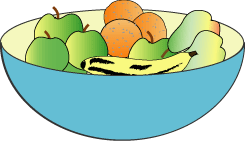Copyright © University of Cambridge. All rights reserved.
'A Bowl of Fruit' printed from https://nrich.maths.org/
Show menu
Why do this problem?
This problem requires a sound understanding of the relationship between part and whole. It could be used as part of a lesson on finding fractions of numbers and quantities.
Possible approach
A good introduction to this problem could be to have the image of a bowl of fruit for all the group to see and to invite them to talk about it. This could be the one in the problem on an interactive whiteboard or another picture. A real bowl of fruit could also be used if that were possible.
You could steer the conversation towards fractions if the children do not naturally bring it up. Asking general questions about the fractions of different fruits in the bowl and referring also to the fraction of "other fruit" will give children the confidence to tackle this problem.
Children should be encouraged to record in any way they find useful while working on this problem. Many may find it helpful to use practical equipment to represent the fruit, for example blocks or counters, perhaps with different colours standing for different types.
Key questions
What fraction of fruit in the bowl is apples?
What fraction of fruit in the bowl is not apples?
Possible extension
Children could make up similar problems for each other to do. Some learners could be encouraged to use cards or symbols and move into a kind of algebra.
